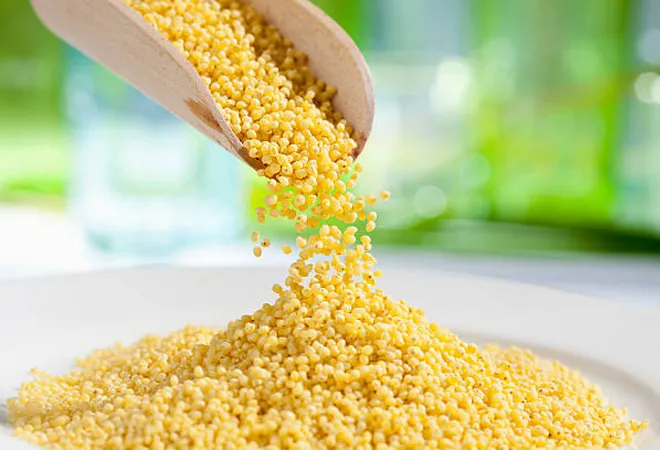- This topic is empty.
- AuthorPosts
- February 12, 2025 at 12:00 pm #562203

Millets, a group of small, ancient grains, have been cultivated for thousands of years and have recently gained attention as a sustainable solution to both agrarian and nutritional challenges.
Known for their resilience in harsh growing conditions, millets are well-suited to a changing climate and can thrive in regions with limited water availability and poor soil quality.
Beyond their agricultural benefits, millets are rich in nutrients and offer a promising solution to address malnutrition, especially in developing regions.
This article explores how millets can play a crucial role in addressing both agrarian and nutritional challenges and why they deserve greater recognition in modern agricultural systems.
1. Agrarian Benefits of Millets
Millets are highly adaptable crops that offer numerous agrarian benefits. One of the primary advantages of growing millets is their ability to thrive in dry, arid, and low-fertility soils.
Unlike more water-intensive crops like rice or wheat, millets are drought-tolerant and require significantly less water, making them an ideal choice for regions prone to water scarcity.
Millets also have a short growing season, which allows farmers to grow multiple crops in a year, increasing agricultural productivity.
Furthermore, these grains are less prone to pests and diseases, reducing the need for chemical interventions and lowering production costs.
Their resilience to extreme weather conditions and ability to grow in marginal environments make millets a valuable crop for ensuring food security in the face of climate change.
2. Millets and Climate Change Adaptation
As the effects of climate change become more pronounced, the agricultural sector faces numerous challenges, including unpredictable rainfall, rising temperatures, and soil degradation. Millets are uniquely suited to help farmers adapt to these challenges.
Their drought resistance, low water requirements, and ability to grow in poor soils make them an ideal crop for areas experiencing increasing environmental stress.
By incorporating millets into crop rotations or as a staple food crop, farmers can diversify their production systems and reduce their vulnerability to climate-related disruptions.
Moreover, millets’ ability to thrive without the need for excessive irrigation or chemical fertilizers makes them a more sustainable choice in the context of global environmental concerns.
3. Nutritional Benefits of Millets
Millets are nutritionally rich, offering a variety of essential nutrients that make them an excellent dietary choice for combating malnutrition.
These grains are high in complex carbohydrates, providing sustained energy without causing rapid spikes in blood sugar levels, making them an ideal food for managing diabetes.
Millets are also a good source of dietary fiber, which aids in digestion, regulates bowel movements, and supports heart health by lowering cholesterol levels.
Additionally, millets are rich in important vitamins and minerals such as iron, magnesium, phosphorus, and B-vitamins, which play vital roles in maintaining healthy bodily functions. Their high antioxidant content further boosts their nutritional value, helping to combat oxidative stress and reduce inflammation in the body.
4. Millets and Food Security
In regions where staple crops like rice and wheat are not viable due to environmental constraints or where food security is an ongoing challenge, millets offer an important alternative.
Millets are nutrient-dense and can be used in a variety of culinary applications, from porridge to bread, providing essential nutrients that can help prevent and address malnutrition.
Additionally, millets have a longer shelf life compared to other grains, which makes them an important food source for areas with limited access to refrigeration or storage facilities.
By promoting the cultivation and consumption of millets, communities can enhance their food security and improve overall health, especially in regions with high rates of micronutrient deficiencies.
5. Millets in Modern Agricultural Systems
Despite their many benefits, millets have been somewhat overlooked in modern agricultural systems, which tend to favor high-yielding cereals like wheat and rice.
However, with increasing interest in sustainable agriculture and the need to address global nutritional challenges, millets are seeing a resurgence. Many countries and organizations are now recognizing the importance of millets for both environmental sustainability and public health.
Efforts are being made to promote millet cultivation through research, policy support, and awareness campaigns.
By integrating millets into contemporary agricultural systems and developing improved varieties with higher yields and disease resistance, millets can play a significant role in creating more sustainable and resilient food systems.
Millets present a promising solution to both agrarian and nutritional challenges. Their adaptability to diverse climates, low water requirements, and resilience to climate change make them an ideal crop for farmers facing environmental uncertainties.
Additionally, the rich nutritional profile of millets can help address malnutrition, especially in regions where micronutrient deficiencies are prevalent.
As the world faces the dual challenges of climate change and food insecurity, millets offer a sustainable and nutritious alternative to conventional crops.
In conclusion, millets are not only a key component of traditional diets but also a powerful tool in building a more resilient and sustainable global food system, addressing both agricultural and nutritional needs in a rapidly changing world.
Read Also: Complete Practical Guide on Millet Farming
- AuthorPosts
- You must be logged in to reply to this topic.

